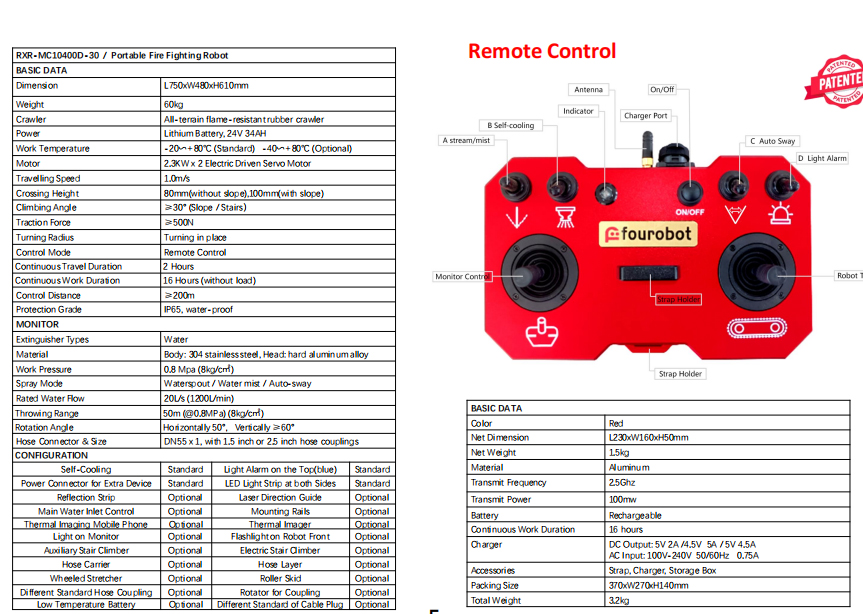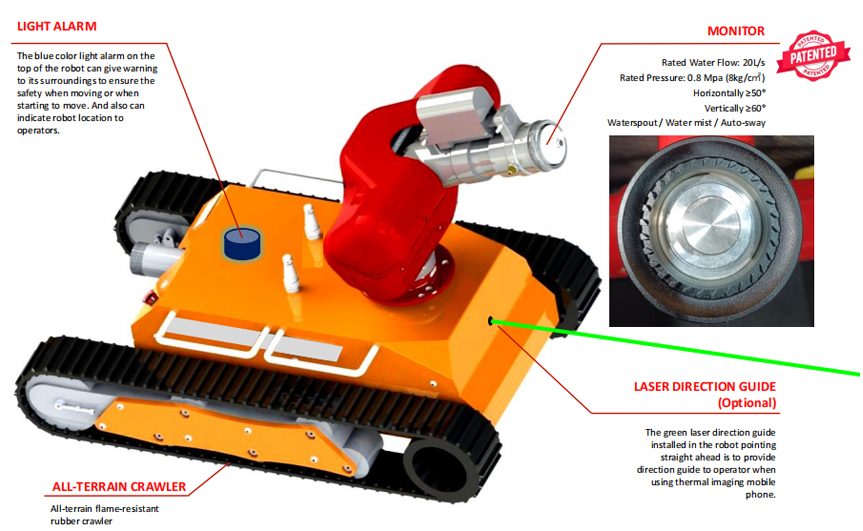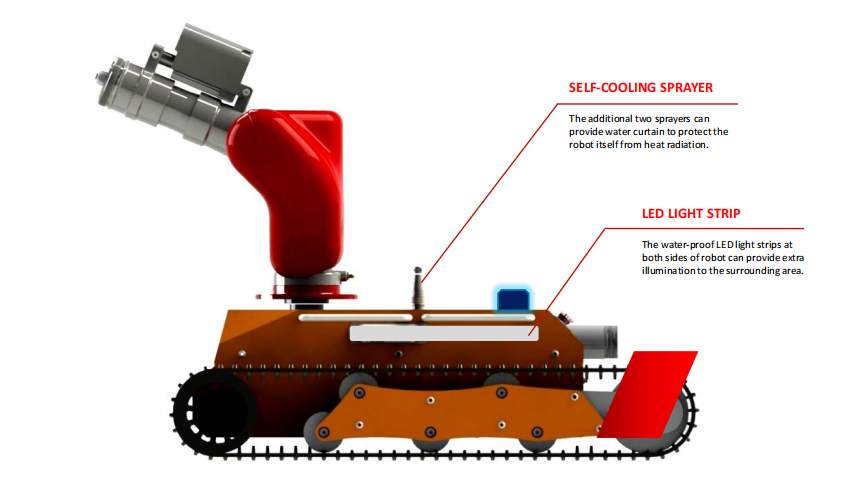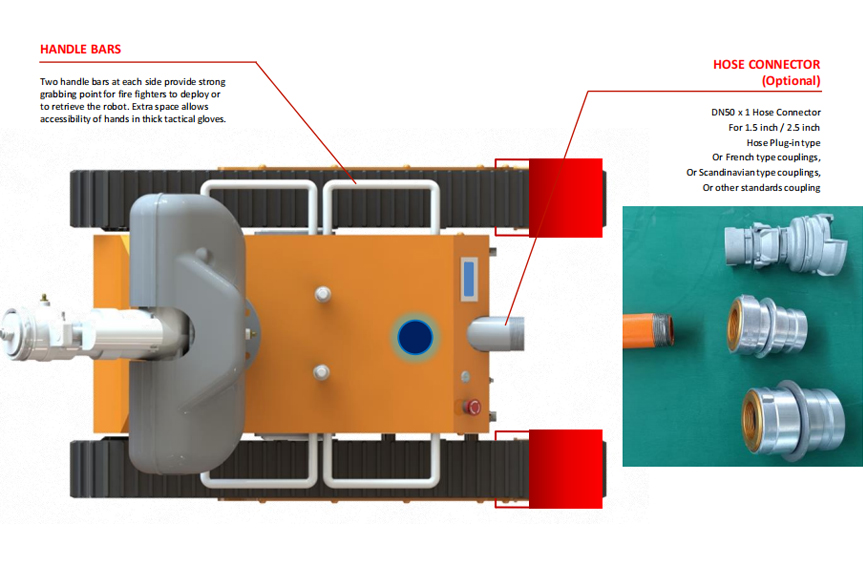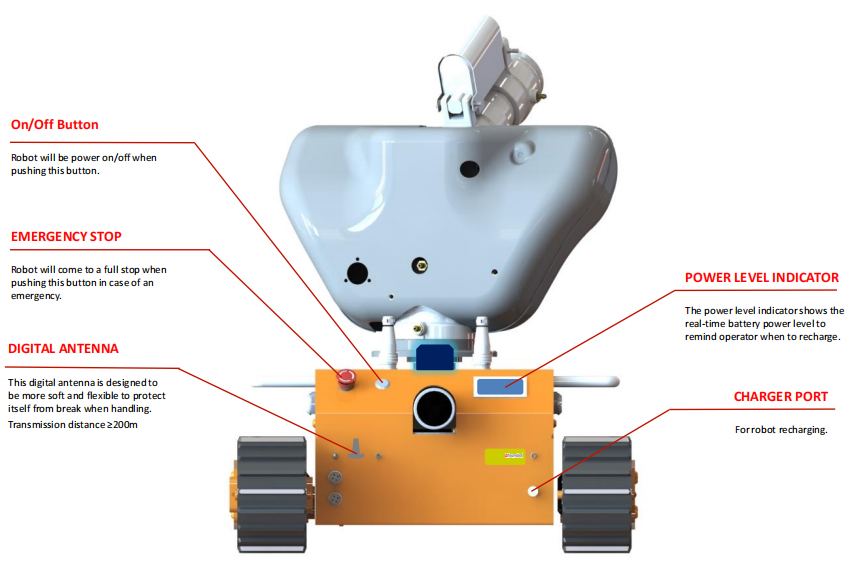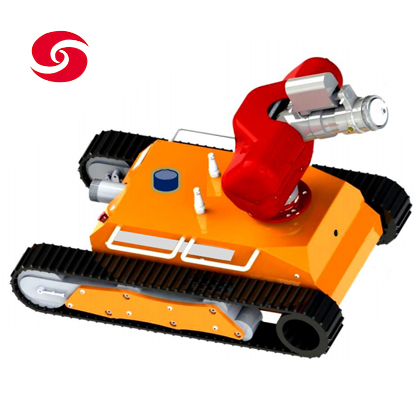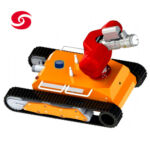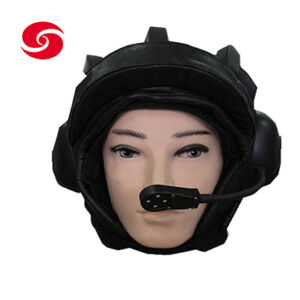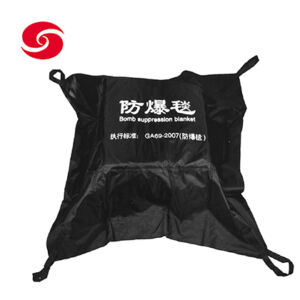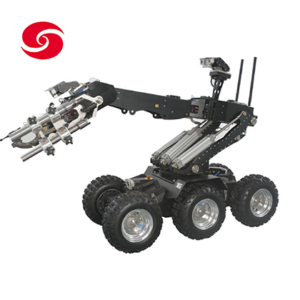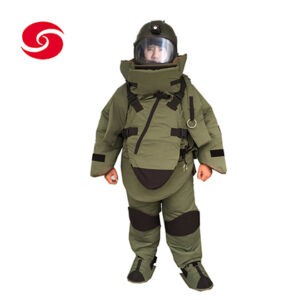This robot consists of robot platform, power pack, remote control, and water cannon. The mini size of the robot makes it quicker to deploy, easier to access to a limited space of a fire scene and handier to keep the robot in a fire truck cabinet after use. This robot is mainly used for fire fighting and rescue missions in cities, chemical industries, tunnels, airports, seaports, steel plants, and factory workshops. It has an important significance in improving the rescue security and reducing human fire-fighter casualties.
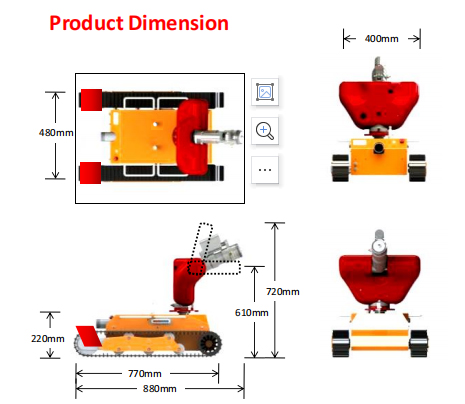
Functions
FIRE FIGHTING
The rated water flow of the Water Monitor is 20L/s, with water spout shoot range over 50m under 0.8MPa water pressure. Auto-sway monitor enables the robot to fight on its own. The human fire-fighters can operate the robot at 200 meters distance away from the explosive and extremely hazardous fire scene while get the job done.
SELF-COOLING
The additional two sprayers can provide water curtain to protect the robot itself from heat radiation.
LIGHT ALARM
The blue color light alarm on the top of the robot can give warning to its surroundings to ensure the safety when moving or when starting to move. And also can indicate robot location to operators.
LED LIGHT STRIP
The water-proof LED light strips at both sides of robot can provide extra illumination to the surrounding area.
RELECTION STRIP (Optional)
The reflection strips on the robot can provide warning reflections for better locating the robot while working at night and for safety reason.
MAIN WATER INLET CONTROL (Optional)
The main water inlet valve on the robot can be turned on/off by remote control when water starts to be pumped into hoses from fire trucks or fire hydrants.
POWER CONNECTOR FOR EXTRA DEVICE(Optional)
The backup power connector hidden inside the monitor casing for supplying power to extra electronic devices such as thermal imaging mobile phone, thermal imager, light, and other applicable devices.
LASER DIRECTION GUIDE (Optional)
The green laser direction guide installed in the robot pointing straight ahead is to provide direction guide to operator when using thermal imaging mobile phone, thermal imager, or cameras.
THERMAL IMAGING MOBILE PHONE (Optional)
The thermal imaging mobile phone is an independent device attached to the monitor. It is a rugged mobile phone for video transmission with built-in thermal imaging, infrared imaging and visible light imaging.
THERMAL IMAGER (Optional)
The thermal imager is an independent device attached to the monitor for video transmission with built-in thermal imaging.
LIGHT ON MONITOR (Optional)
The light is attached to the monitor, functioning as monitor aiming light to provide extra illumination when working at night.
FLASHLIGHTS ON FRONT (Optional)
The auxiliary flashlights are independent devices attached to the both sides of robot front, functioning as head lights to provide extra illumination when working at night.
AUXILIARY STAIR CLIMBER (Optional)
The auxiliary stair climber is usually mounted on top of robot front. It is easy to remove from robot front and used for robot to climb onto the first stair.
ELECTRIC STAIR CLIMBER (Optional)
The electric stair climber is used for transporting robot to upstairs. It is also for transporting other heavy rescue equipment to upstairs.
MOUNTING RAILS (Optional)
Used for refitting life detectors, communication repeaters, laser combustible gas detectors, on-site air monitors, nuclear radiation detectors, military poison detectors, loudspeaker, sound pickups and other accessories.All these accessories are separate from robot control system.
ROLLER SKID (Optional)
The roller skid is to be mounted into the fire truck compartment, which is convenient for firefighters to put in or take out the robot from the fire truck compartment by sliding the robot in or out on the roller tray.
WHEELED STRETCHER (Optional)
The robot can be equipped with a wheeled stretcher to carry the wounded personnel or materials such as oxygen cylinders, fire-fighting hatchets, break-in tools, water, foods, and other materials to save human fire fighters’ energy.
HOSE CARRIER (Optional)
The hose carrier can be used alone or in conjunction with the robot to reduce the contact area between the hose and the ground, thereby reducing the friction between the hose and the ground, so that the robot can pull much longer charged hoses.
HOSE LAYER (Optional)
The hose layer can be used alone or along with the robot to ensure the hoses are arranged evenly without twists and knots on the ground.
ROTATOR FOR COUPLING (Optional)
The rotator for coupling is to prevent hoses from getting twists and knots robot is moving.
LOW TEMPERATURE BATTERY (Optional)
Low temperature battery can be optional for the robot when the robot has to be deployed to a region where the climate is always with low temperature.
